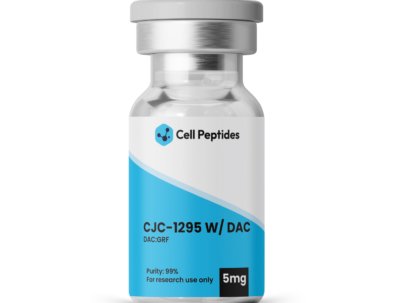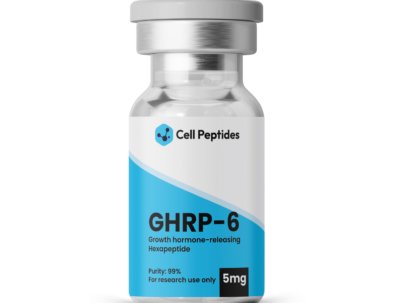- Fast shipping in Europe & USA
- Made in ISO 9001:2015 certified lab
- info@cellpeptides.com
IGF-1 and growth hormone peptides are widely studied in scientific research for their roles in supporting anabolic activity, tissue regeneration, fat metabolism, and anti-aging mechanisms. By stimulating the body’s natural growth hormone release or mimicking aspects of the IGF-1 pathway, these compounds are used in a variety of preclinical models related to muscle repair, recovery, and metabolic health.
“IGF-1 & Growth Hormone Peptides” refers to a category of research peptides that stimulate the secretion of growth hormone (GH) and activate downstream pathways involving insulin-like growth factor 1 (IGF-1). These peptides are investigated in various preclinical models for their ability to promote anabolic processes, improve recovery after injury, and influence body composition.
Research applications include muscle hypertrophy, tissue healing, enhanced fat metabolism, and even cognitive or neuroprotective effects linked to GH signaling. Compounds in this category typically act on the hypothalamus or pituitary gland to increase GH secretion or support IGF-1 production in the liver and peripheral tissues. Their role in regenerative medicine and metabolic studies continues to grow as more data emerges from controlled laboratory research.
Disclaimer: All peptides discussed are for laboratory research use only. Effects described here are based on preclinical and experimental data and are not intended as medical or therapeutic claims.
Growth hormone (GH) and IGF-1 peptides are short-chain amino acid compounds studied for their ability to stimulate natural growth hormone release or directly influence the IGF-1 pathway. These peptides play a central role in laboratory research related to muscle development, fat metabolism, tissue repair, and age-related decline.
GH is released by the pituitary gland and triggers the liver and other tissues to produce IGF-1 (insulin-like growth factor 1), which in turn supports muscle hypertrophy, fat oxidation, skin rejuvenation, and recovery processes. In preclinical models, this axis is also associated with improvements in cognition, metabolic function, and resilience to injury.
Key categories include:
These peptides are used in laboratory environments only and are not approved for therapeutic use.
Peptides that influence the GH and IGF-1 pathways work by either stimulating growth hormone secretion or mimicking downstream signals that promote anabolic and regenerative responses. These compounds are typically categorized by their mode of action and biological targets.
GHRH Analogs:
GH Secretagogues (GHRPs):
GH-Releasing Analog:
IGF-1 Pathway Analog:
All peptides described are strictly for laboratory research use only.
The peptides in this category have been widely explored across aging, metabolic, and muscle regeneration studies. While some have limited clinical application, most findings are derived from animal models or early-phase trials.
Note: All peptides mentioned are intended for laboratory research use only. Their effects in humans are presented solely for informational reference based on preclinical data.
Among the peptides in this category, Tesamorelin is the only one currently FDA-approved, specifically for treating HIV-associated lipodystrophy. The rest, including CJC-1295, Sermorelin, GHRP-6, Ipamorelin, and PEG MGF, are strictly designated for laboratory research use only. They are not approved for medical or therapeutic application in humans.
In research settings, several effects have been observed across different models:
To maintain reliability and safety, these peptides must be handled with aseptic technique, reconstituted using sterile solvents (e.g., bacteriostatic water), and stored according to the manufacturer’s recommendations, typically at –20°C for lyophilized powders and 2–8°C after reconstitution.
Reminder: All peptides listed are for research use only. Any reference to their effects in humans is based on scientific or experimental data and does not constitute medical advice or support for off-label use.
Several peptides stand out in GH and IGF-1–focused studies for their role in promoting growth, recovery, and hormonal regulation. Below are top research compounds available at CellPeptides:
These peptides are available for laboratory research use only and should be handled under approved lab conditions.
For consistent and replicable outcomes in GH and IGF-1–based studies, correct reconstitution and handling of peptides are essential. Most peptides in this category, including CJC-1295, GHRP-6, Ipamorelin, Sermorelin, and Tesamorelin, can be reconstituted using bacteriostatic water. However, PEG MGF may require a pH-neutral buffer to maintain solubility and activity.
Store lyophilized peptides at –20 °C in a dry, dark environment. Once reconstituted, keep the vials refrigerated at 2–8 °C and use within 7 to 14 days, depending on protocol.
Typical dosing in preclinical animal models ranges from 0.1–2 mg/kg, based on the peptide’s pharmacodynamics and research objective.
Common endpoints for GH and IGF-1 peptide studies include:
All peptides must be handled with sterile tools and aseptic techniques to ensure accuracy and avoid contamination. These products are intended for research use only and are not approved for therapeutic or diagnostic purposes.
Yes. They are frequently stacked in preclinical studies to produce a synergistic release of growth hormone through dual stimulation of the GHRH and GHRP pathways.
GHRP-6 is known for stimulating appetite and can affect cortisol and prolactin levels. Ipamorelin, on the other hand, is highly selective for GH release and has minimal impact on other hormones, making it more targeted for specific GH research models.
PEGylation increases its half-life, enabling sustained action at muscle tissue. This supports prolonged IGF-1 pathway stimulation and may improve outcomes in muscle regeneration studies.
Yes, but always check for chemical compatibility and pH solubility before combining. Reconstitute under sterile lab conditions and validate dosages according to your experimental model.
We can conclude that IGF-1 and growth hormone peptides play a vital role in laboratory research exploring muscle hypertrophy, fat metabolism, recovery, and cellular regeneration. Compounds such as CJC-1295, GHRP-6, Ipamorelin, PEG MGF, Sermorelin, and Tesamorelin each contribute uniquely to stimulating the GH/IGF-1 axis. Their mechanisms support a wide range of studies in anti-aging, endocrine modulation, and performance research.
To advance your experimental protocols, browse the full selection of GH and IGF-1 research peptides at CellPeptides.
IGF-1 & Growth Hormone Peptides
IGF-1 and growth hormone peptides are widely studied in scientific research for their roles in supporting anabolic activity, tissue regeneration, fat metabolism, and anti-aging mechanisms. By stimulating the body’s natural growth hormone release or mimicking aspects of the IGF-1 pathway, these compounds are used in a variety of preclinical models related to muscle repair, recovery, and metabolic health.
“IGF-1 & Growth Hormone Peptides” refers to a category of research peptides that stimulate the secretion of growth hormone (GH) and activate downstream pathways involving insulin-like growth factor 1 (IGF-1). These peptides are investigated in various preclinical models for their ability to promote anabolic processes, improve recovery after injury, and influence body composition.
Research applications include muscle hypertrophy, tissue healing, enhanced fat metabolism, and even cognitive or neuroprotective effects linked to GH signaling. Compounds in this category typically act on the hypothalamus or pituitary gland to increase GH secretion or support IGF-1 production in the liver and peripheral tissues. Their role in regenerative medicine and metabolic studies continues to grow as more data emerges from controlled laboratory research.
Disclaimer: All peptides discussed are for laboratory research use only. Effects described here are based on preclinical and experimental data and are not intended as medical or therapeutic claims.
Growth hormone (GH) and IGF-1 peptides are short-chain amino acid compounds studied for their ability to stimulate natural growth hormone release or directly influence the IGF-1 pathway. These peptides play a central role in laboratory research related to muscle development, fat metabolism, tissue repair, and age-related decline.
GH is released by the pituitary gland and triggers the liver and other tissues to produce IGF-1 (insulin-like growth factor 1), which in turn supports muscle hypertrophy, fat oxidation, skin rejuvenation, and recovery processes. In preclinical models, this axis is also associated with improvements in cognition, metabolic function, and resilience to injury.
Key categories include:
These peptides are used in laboratory environments only and are not approved for therapeutic use.
Peptides that influence the GH and IGF-1 pathways work by either stimulating growth hormone secretion or mimicking downstream signals that promote anabolic and regenerative responses. These compounds are typically categorized by their mode of action and biological targets.
GHRH Analogs:
GH Secretagogues (GHRPs):
GH-Releasing Analog:
IGF-1 Pathway Analog:
All peptides described are strictly for laboratory research use only.
The peptides in this category have been widely explored across aging, metabolic, and muscle regeneration studies. While some have limited clinical application, most findings are derived from animal models or early-phase trials.
Note: All peptides mentioned are intended for laboratory research use only. Their effects in humans are presented solely for informational reference based on preclinical data.
Among the peptides in this category, Tesamorelin is the only one currently FDA-approved, specifically for treating HIV-associated lipodystrophy. The rest, including CJC-1295, Sermorelin, GHRP-6, Ipamorelin, and PEG MGF, are strictly designated for laboratory research use only. They are not approved for medical or therapeutic application in humans.
In research settings, several effects have been observed across different models:
To maintain reliability and safety, these peptides must be handled with aseptic technique, reconstituted using sterile solvents (e.g., bacteriostatic water), and stored according to the manufacturer’s recommendations, typically at –20°C for lyophilized powders and 2–8°C after reconstitution.
Reminder: All peptides listed are for research use only. Any reference to their effects in humans is based on scientific or experimental data and does not constitute medical advice or support for off-label use.
Several peptides stand out in GH and IGF-1–focused studies for their role in promoting growth, recovery, and hormonal regulation. Below are top research compounds available at CellPeptides:
These peptides are available for laboratory research use only and should be handled under approved lab conditions.
For consistent and replicable outcomes in GH and IGF-1–based studies, correct reconstitution and handling of peptides are essential. Most peptides in this category, including CJC-1295, GHRP-6, Ipamorelin, Sermorelin, and Tesamorelin, can be reconstituted using bacteriostatic water. However, PEG MGF may require a pH-neutral buffer to maintain solubility and activity.
Store lyophilized peptides at –20 °C in a dry, dark environment. Once reconstituted, keep the vials refrigerated at 2–8 °C and use within 7 to 14 days, depending on protocol.
Typical dosing in preclinical animal models ranges from 0.1–2 mg/kg, based on the peptide’s pharmacodynamics and research objective.
Common endpoints for GH and IGF-1 peptide studies include:
All peptides must be handled with sterile tools and aseptic techniques to ensure accuracy and avoid contamination. These products are intended for research use only and are not approved for therapeutic or diagnostic purposes.
Yes. They are frequently stacked in preclinical studies to produce a synergistic release of growth hormone through dual stimulation of the GHRH and GHRP pathways.
GHRP-6 is known for stimulating appetite and can affect cortisol and prolactin levels. Ipamorelin, on the other hand, is highly selective for GH release and has minimal impact on other hormones, making it more targeted for specific GH research models.
PEGylation increases its half-life, enabling sustained action at muscle tissue. This supports prolonged IGF-1 pathway stimulation and may improve outcomes in muscle regeneration studies.
Yes, but always check for chemical compatibility and pH solubility before combining. Reconstitute under sterile lab conditions and validate dosages according to your experimental model.
We can conclude that IGF-1 and growth hormone peptides play a vital role in laboratory research exploring muscle hypertrophy, fat metabolism, recovery, and cellular regeneration. Compounds such as CJC-1295, GHRP-6, Ipamorelin, PEG MGF, Sermorelin, and Tesamorelin each contribute uniquely to stimulating the GH/IGF-1 axis. Their mechanisms support a wide range of studies in anti-aging, endocrine modulation, and performance research.
To advance your experimental protocols, browse the full selection of GH and IGF-1 research peptides at CellPeptides.





